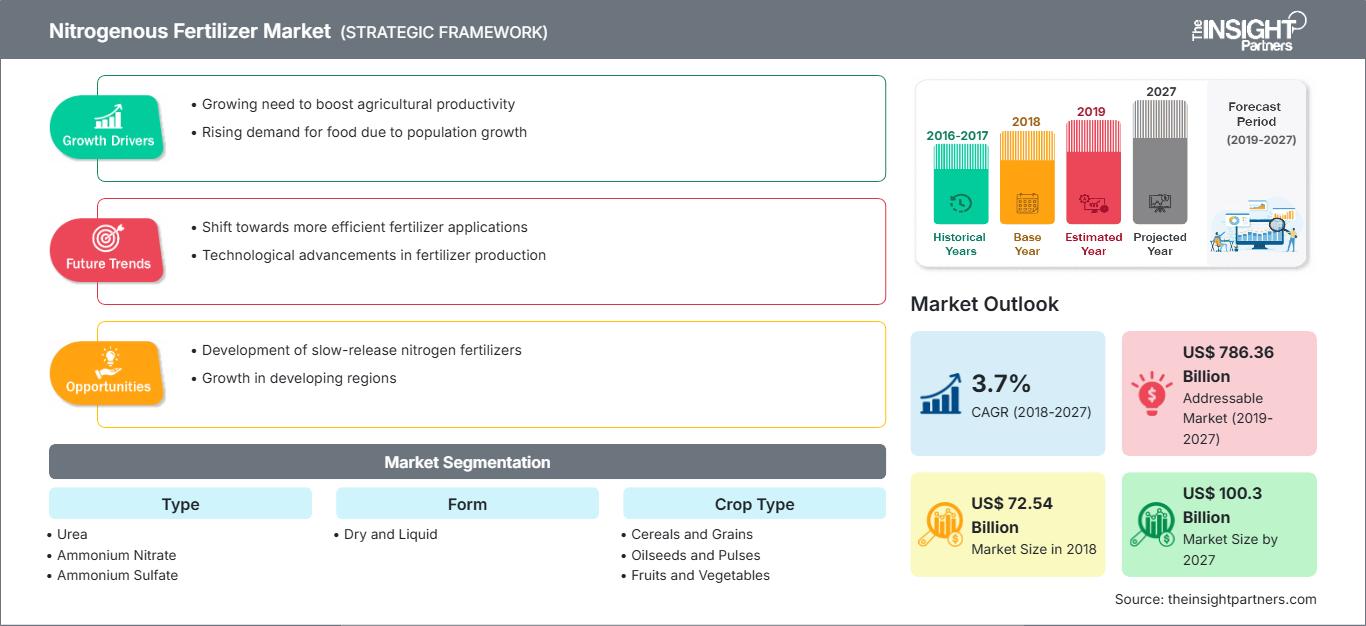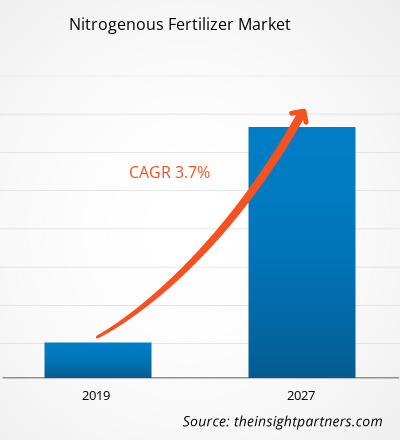Der Markt für Stickstoffdünger wurde 2018 auf 72.537,57 Millionen US-Dollar geschätzt und soll von 2019 bis 2027 mit einer durchschnittlichen jährlichen Wachstumsrate von 3,7 % wachsen und bis 2027 100.304,42 Millionen US-Dollar erreichen.
Stickstoffdünger wird durch die Nutzung von Stickstoff aus der Luft hergestellt und anschließend einer komplexen chemischen Reaktion unterzogen. Stickstoff fördert das Wachstum von Nutzpflanzen, verleiht Pflanzen eine bessere Textur und Farbe und trägt so zur Verbesserung der landwirtschaftlichen Produktivität bei. Das Haber-Bosch-Verfahren gilt als das am häufigsten verwendete Verfahren zur Herstellung von Stickstoffdünger. Erdgas ist einer der wichtigsten Rohstoffe, der im Haber-Bosch-Verfahren neben anderen Rohstoffen wie Tiermist und Kompost verwendet wird. Das Bevölkerungswachstum hat die Nachfrage nach Ernährungssicherheit in die Höhe getrieben und somit den Einsatz solcher Düngemittel zur Versorgung des Bodens mit wichtigen Nährstoffen und zur Verbesserung der Bodenqualität sowie letztlich zu höheren Erträgen erforderlich gemacht.
Der Markt für Stickstoffdünger in Nordamerika wird im Prognosezeitraum voraussichtlich die höchste durchschnittliche jährliche Wachstumsrate (CAGR) aufweisen. Nordamerika ist der am schnellsten wachsende Markt für Stickstoffdünger, da die Verwendung von Stickstoffdünger zunimmt und positive staatliche Maßnahmen das Wachstum der Branche unterstützen. Darüber hinaus dürften steigende verfügbare Einkommen in Verbindung mit erhöhten Investitionen in bessere landwirtschaftliche Anlagen die Nachfrage nach Stickstoffdünger auf dem nordamerikanischen Markt ebenfalls ankurbeln. Die durch die Verwendung solcher synthetischen Düngemittel entstehenden Umwelt- und Gesundheitsrisiken haben jedoch zu einer verstärkten Nutzung biologischer Agrarprodukte geführt. Dies könnte das Wachstum des Marktes für Stickstoffdünger hemmen.
Passen Sie diesen Bericht Ihren Anforderungen an
Sie erhalten kostenlos Anpassungen an jedem Bericht, einschließlich Teilen dieses Berichts oder einer Analyse auf Länderebene, eines Excel-Datenpakets sowie tolle Angebote und Rabatte für Start-ups und Universitäten.
Markt für Stickstoffdünger: Strategische Einblicke

-
Holen Sie sich die wichtigsten Markttrends aus diesem Bericht.Dieses KOSTENLOSE Beispiel umfasst Datenanalysen, die von Markttrends bis hin zu Schätzungen und Prognosen reichen.
Kommerzielle Landwirtschaft definiert sich grundsätzlich als der Anbau von Nutzpflanzen, um die Produkte gewinnbringend auf dem Inlands- oder Exportmarkt zu verkaufen. Die kommerzielle Landwirtschaft hat sich reformiert und eine allmähliche Entwicklung im Agrarsektor eingeleitet. Das Bevölkerungswachstum, gepaart mit dem Einsatz verbesserter Technologien und besserer Infrastruktureinrichtungen, haben das Wachstum der kommerziellen Landwirtschaft positiv beeinflusst. Die Entwicklungen in der Agrarindustrie haben den Grundstein für den Einsatz von Technologien und hochwertigen Düngemitteln zur Ertragssteigerung gelegt, beispielsweise stickstoffbasierte Düngemittel. Somit bringt das Wachstum der kommerziellen Landwirtschaft auch eine steigende Nachfrage nach stickstoffhaltigen Düngemitteln mit sich. So hat beispielsweise die Einführung und Verwendung von umhülltem Harnstoff, gepaart mit der steigenden Nachfrage nach Düngemitteln mit N-, P- und K-Mischungen und der Einführung von umhülltem Dünger mit Hefe, in der Agrarindustrie an Bedeutung gewonnen, um die Bodenfruchtbarkeit zu verbessern. Heute setzt die Mehrheit der landwirtschaftlichen Betriebe moderne Maschinen und hochentwickelte Technologien ein. Beispielsweise ist der Einsatz von Bodensensoren und Drohnen zu einem wesentlichen Bestandteil der Landwirtschaft im großen Stil geworden, und die vertikale Landwirtschaft wird voraussichtlich zahlreiche Fortschritte machen, indem Pflanzen ohne Sonnenlicht oder Erde geerntet werden.
Produktinformationen
Basierend auf der Anwendung wird in Harnstoff, Ammoniumnitrat, Ammoniumsulfat, Ammoniak, Kalkammonsalpeter und andere segmentiert. Das Harnstoffsegment hatte 2018 den größten Anteil am Weltmarkt, während der Markt für Ammoniumsulfat im Prognosezeitraum voraussichtlich mit der höchsten CAGR wachsen wird. Eine der ersten festen Stickstoffquellen, die in großem Maßstab hergestellt wurde, ist Ammoniumnitrat. Ammoniumnitratdünger ist von Natur aus sehr flüchtig, was ihn in bestimmten Branchen nützlich macht. Ammoniumnitrat ist ein nahezu farbloses und geruchloses Kristallsalz. Die Anwendung von Ammoniumnitrat in Gärten und auf großen landwirtschaftlichen Feldern verbessert das Pflanzenwachstum und liefert den Pflanzen Stickstoff, aus dem sie schöpfen können. Ammoniumnitratdünger ist eine einfach herzustellende Verbindung. Es entsteht, wenn Ammoniakgas mit Salpetersäure reagiert. Durch die chemische Reaktion entsteht eine konzentrierte Formel aus Ammoniumnitrat, die enorme Mengen Wärme erzeugt. Als Düngemittel wird die Verbindung als Granulat ausgestrichen und mit Ammoniumsulfat verschmolzen, um die Flüchtigkeit der Verbindung zu verringern.
Anwendungseinblicke
Basierend auf der Art der Ernte wird in Getreide und Körner, Ölsaaten und Hülsenfrüchte, Obst und Gemüse und Sonstiges segmentiert. Das Segment Getreide und Körner hatte 2018 den größten Marktanteil, während das Segment Ölsaaten und Hülsenfrüchte im Prognosezeitraum voraussichtlich die höchste durchschnittliche jährliche Wachstumsrate verzeichnen wird. Alle Ölsaaten und Hülsenfrüchte benötigen Stickstoff in mäßig großen Mengen. Stickstoff ist der limitierendste Nährstoff in der Ölsaaten- und Hülsenfruchtproduktion weltweit. Pflanzen nehmen normalerweise den größten Teil ihres Stickstoffs in Form von Nitratstickstoff aus dem Boden auf. Wenn der Stickstoffgehalt im Boden ausreichend ist, fördert Stickstoff dynamisches Wachstum und eine größere Blattfläche mit dunkelgrüner Farbe. Bodenanalysen sind sehr hilfreich, um den Bedarf an Stickstoffdünger abzuschätzen. Die weltweit steigende Nachfrage nach Ölen und Hülsenfrüchten war einer der Hauptfaktoren für die Ausweitung der Verwendung von Stickstoffdünger. Die zunehmende Neigung der Menschen zu einem gesunden Lebensstil hat aufgrund der gesundheitlichen Vorteile zu einem steigenden Konsum von Ölsaaten und Hülsenfrüchten geführt. All diese Faktoren haben die Nachfrage nach Stickstoffdünger angeheizt und auch zur weltweiten Expansion des Marktes beigetragen.
Einige Akteure auf dem Markt für Stickstoffdünger sind Bunge Limited, CF Industries Holdings, Inc., EuroChem Group, Koch Fertilizer, Llc, Nutrien Ltd. und OCI Nitrogen. Die wichtigsten Unternehmen setzen Fusionen und Übernahmen sowie Forschungs- und Entwicklungsstrategien um, um ihren Kundenstamm zu erweitern und bedeutende Marktanteile auf dem Weltmarkt zu gewinnen. Dies ermöglicht ihnen auch, ihren Markennamen weltweit zu behaupten.
Berichts-Spotlights
- Fortschreitende Branchentrends auf dem Markt für Stickstoffdünger, um den Akteuren bei der Entwicklung effektiver langfristiger Strategien zu helfen
- Geschäftswachstumsstrategien in entwickelten und sich entwickelnden Märkten
- Quantitative Analyse des Marktes für Stickstoffdünger von 2019 bis 2027
- Schätzung der weltweiten Nachfrage nach Stickstoffdünger
- PEST-Analyse zur Veranschaulichung der Wirksamkeit von Käufern und Lieferanten in der Branche
- Jüngste Entwicklungen zum Verständnis des Wettbewerbsmarktszenarios
- Markttrends und -aussichten sowie Faktoren, die das Wachstum des Marktes für Stickstoffdünger vorantreiben und hemmen
- Unterstützung im Entscheidungsprozess durch Hervorhebung von Marktstrategien, die das kommerzielle Interesse untermauern und zum Marktwachstum führen
- Die Größe des Marktes für Stickstoffdünger Größe an verschiedenen Knotenpunkten
- Detaillierter Überblick und Segmentierung des Marktes sowie der Dynamik der Stickstoffdüngerbranche
- Größe des Stickstoffdüngermarktes in verschiedenen Regionen mit vielversprechenden Wachstumschancen
Stickstoffdünger
Regionale Einblicke in den Markt für StickstoffdüngerDie Analysten von The Insight Partners haben die regionalen Trends und Faktoren, die den Markt für Stickstoffdünger im Prognosezeitraum beeinflussen, ausführlich erläutert. In diesem Abschnitt werden auch die Marktsegmente und die geografische Verteilung von Stickstoffdünger in Nordamerika, Europa, im asiatisch-pazifischen Raum, im Nahen Osten und Afrika sowie in Süd- und Mittelamerika erörtert.
Umfang des Marktberichts über stickstoffhaltige Düngemittel
| Berichtsattribut | Einzelheiten |
|---|---|
| Marktgröße in 2018 | US$ 72.54 Billion |
| Marktgröße nach 2027 | US$ 100.3 Billion |
| Globale CAGR (2018 - 2027) | 3.7% |
| Historische Daten | 2016-2017 |
| Prognosezeitraum | 2019-2027 |
| Abgedeckte Segmente |
By Typ
|
| Abgedeckte Regionen und Länder |
Nordamerika
|
| Marktführer und wichtige Unternehmensprofile |
|
Dichte der Marktteilnehmer für Stickstoffdünger: Verständnis ihrer Auswirkungen auf die Geschäftsdynamik
Der Markt für Stickstoffdünger wächst rasant. Die steigende Nachfrage der Endverbraucher ist auf Faktoren wie veränderte Verbraucherpräferenzen, technologische Fortschritte und ein stärkeres Bewusstsein für die Produktvorteile zurückzuführen. Mit der steigenden Nachfrage erweitern Unternehmen ihr Angebot, entwickeln Innovationen, um den Bedürfnissen der Verbraucher gerecht zu werden, und nutzen neue Trends, was das Marktwachstum weiter ankurbelt.

- Holen Sie sich die Markt für Stickstoffdünger Übersicht der wichtigsten Akteure
Markt für Stickstoffdünger – nach Typ
- Harnstoff
- Ammoniumnitrat
- Ammoniumsulfat
- Ammoniak
- Calciumammoniumnitrat
- Sonstige
Markt für Stickstoffdünger – nach Form
- Trocken
- Flüssig
Markt für Stickstoffdünger – nach Pflanzenart
- Getreide und Körner
- Ölsaaten und Hülsenfrüchte
- Obst und Gemüse
- Sonstige
Firmenprofile
- Bunge Limited
- CF Industries Holdings, Inc.
- EuroChem Group
- Koch Fertilizer, Llc
- Nutrien Ltd.
- OCI Nitrogen
- SABIC Group
- Sinofert
- TOGLIATTIAZOT (TOAZ)
- Yara International ASA
- Historische Analyse (2 Jahre), Basisjahr, Prognose (7 Jahre) mit CAGR
- PEST- und SWOT-Analyse
- Marktgröße Wert/Volumen – Global, Regional, Land
- Branchen- und Wettbewerbslandschaft
- Excel-Datensatz
Aktuelle Berichte
Verwandte Berichte
Erfahrungsberichte
Grund zum Kauf
- Fundierte Entscheidungsfindung
- Marktdynamik verstehen
- Wettbewerbsanalyse
- Kundeneinblicke
- Marktprognosen
- Risikominimierung
- Strategische Planung
- Investitionsbegründung
- Identifizierung neuer Märkte
- Verbesserung von Marketingstrategien
- Steigerung der Betriebseffizienz
- Anpassung an regulatorische Trends






















 Kostenlose Probe anfordern für - Markt für Stickstoffdünger
Kostenlose Probe anfordern für - Markt für Stickstoffdünger